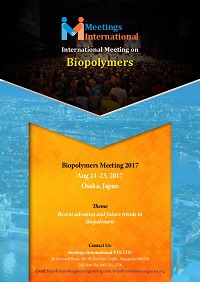
Biopolymers Meeting 2017

Theme: Recent advances and future trends in Biopolymers and Polymer Sciences
The global bioplastics & biopolymers market is projected to witness a CAGR of 12.0% from 2016 to reach a market size of USD 5.08 Billion by 2021. This growth is mainly driven by the implementation of strict environmental regulations to reduce carbon content and fluctuating fuel prices which is compelling manufacturers to use a stable source of raw material.
Meetings International proudly announces the Annual Meeting on Biopolymers and Drug Delivery Systems’ (Biopolymers Meeting 2017) scheduled during October 12-13 2017 at Osaka, Japan. With a theme of “Recent advances and future trends in Biopolymers and Polymer Sciences". The conference provides a Global Platform for Pharma, Biotech, Medical and Healthcare Professionals to Exchange Ideas, Knowledge and Networking at its 100+ International Conferences.
Biopolymers are chain-like molecules made up of repeating chemical blocks and can be very long in length. Depending on the nature of the repeating unit they are made of polysaccharides, proteins of amino acids, and nucleic acids of nucleotides. The studies are more concerned to Green Composites, Biopolymer Feed Stock Challenges, Bio fibers & Microbial Cellulose, Biomaterials and Bio plastics. Advanced studies are being made to improvise developments in Biopolymer Technology, Waste Management, pharmaceutical and biomedical applications, Biodegrade ability, and much more.
Biopolymer Meeting 2017 will bring together key decision makers and innovators within this rapidly growing field. This intensive 2-Day program will examine various Biopolymer strategies. The event will cover Biopolymers, Advanced Biopolymers, Biodegradable Polymers, Bio-Renewable Biopolymers, Biopolymers as Materials, Polymeric Biomaterials etc.
Importance and Scope:
Over the past few years, global economic activities have increased a lot. This tremendous growth has raised serious problems about current important patterns of production and consumption. As the current society has increased its attention in understanding of the environmental aspects and its industrial practices, greater attention has been given to the concept of sustainable economic systems that rely on energy from undepletable source and materials. The use of biologically derived Polymers become an important component of this global world.
The history of Biopolymer is not a long one. Various reasons are associated with the research and development of Biopolymers. Use of Bio plastics will make a tremendous change and will help rid of the conventional plastics, which is a welcome change.
Meetings International Biopolymer Meeting will offer you an unmatched attendee experience. In addition to the many scientific sessions and take-home case study examples, you will leave this event with many other novel development strategies from some of our workshops and symposiums. Engage in dynamic conversation with your industry peers at our multiple networking sessions, and takeaway novel drug development and commercialization strategies, which could speed up time to market and save your organization millions. We hope you will join us in Osaka, Japan this October to enhance your drug delivery capabilities, and increase time to market on therapeutics.
Sincerely,
Operating Committee
CEO and Founder
Meetings International PTE LTD

Biopolymers are polymers that bio-debase with the activity of smaller scale life forms, warmth and dampness. There is no particular standard for biodegradation. Biopolymers can be made utilizing waste starch from a harvest that has been developed for sustenance utilize
Biopolymers, the most encouraging of which is Polylactide (PLA), are a kind of plastic which, rather than being fabricated from petrochemicals, are produced using feasible feedstocks, for example, sugar, starch or Cellulose. Till date, the utilization of biopolymers, including original PLA, has been restricted by their Physical properties and generally high cost of make. Cutting edge biopolymers, including Plastic part manufacture, Polysaccharides second era PLA, are relied upon to be less expensive and to offer enhanced execution and a more extensive application achieve, empowering them to catch an expanding offer of the different markets for Biopolymers. Advancements has as of now made critical progress with its initial ventures its £1.5m interest in stoutness tranquilize designer return up to £22m, taking after its deal for£100m in 2013, while the offer of Respivert, a little particle sedate revelation organization, brought about Innovations acknowledging £9.5m, a 4.7 rate of profitability. In the year to2015, Innovations put £14.0m in 20 wanders, propelling three new organizations.
Biodegradable polymers are defined as Polymers comprised of monomers linked to one another through functional groups and have unstable links in the backbone. They are broken down intlo biologically acceptable molecules that are metabolized and removed from the body via normal metabolic pathways.
For polymers the terms “Renewably-sourced” and ”bio-based” mean the same thing. They refer to a material that contains carbon originating from a renewable plant source. Materials are defined as renewably sourced when they contain a minimum of 20% by weight of plant sourced ingredients verified by 14C dating (ASTM definition).
Benefits of specifying biopolymers, made from a renewable plant source, or biomass, can include LEED certification points, and reduction in use of fossil fuels. At the same time, DuPont biopolymers provide durability and other qualities that enable application-critical performance in demanding applications.
Polymer Nano composites (PNC) comprise of a polymer or copolymer having nanoparticles or Nano fillers scattered in the polymer network. Plastic bundling for sustenance and non-nourishment applications is non-biodegradable, and furthermore goes through profitable and rare non-renewable assets like petroleum. With the momentum concentrate on investigating other options to petroleum and accentuation on diminished natural effect, research is progressively being coordinated at improvement of biodegradable nourishment bundling from biopolymer-based materials. A biomaterial is any matter, surface, or develop that connects with organic frameworks. As a science, biomaterials are around fifty years of age. The investigation of biomaterials is called biomaterials science. It has encountered consistent and solid development over its history, with many organizations putting a lot of cash into the improvement of new items. Biomaterials science includes components of solution, science, science, tissue designing and materials science. Worldwide Biomaterial advertise over the figure time of 2012-2017 market for biomaterials is evaluated at $44.0 billion in 2012 and is ready to develop at a CAGR of 15% from 2012 to 2017 to reach $88.4 billion by 2017
Synthetic polymeric materials have been widely used in medical disposable supply, prosthetic materials, dental materials, implants, dressings, extracorporeal devices, encapsulants, polymeric drug delivery systems, tissue engineered products, and orthodoses as that of metal and ceramics substituents. The main advantages of the polymeric biomaterials compared to metal or ceramic materials are ease of manufacturability to produce various shapes (latex, film, sheet, fibers, etc.), ease of secondary processability, reasonable cost, and availability with desired mechanical and physical properties. The required properties of polymeric biomaterials are similar to other biomaterials, that is, biocompatibility, sterilizability, adequate mechanical and physical properties, and manuflicturability.
Biopolymers: Applications and Trends provides an up-to-date summary of the varying market applications of biopolymers characterized by biodegradability and sustainability. It includes tables with the commercial names and properties of each biopolymer family, along with biopolymers for each marketing segment, not only presenting all the major market players, but also highlighting trends and new developments in products.
Biopolymers for Tissue Engineering
Tissue engineering has been an area of immense research in recent years because of its vast potential in the repair or replacement of damaged tissues and organs. The present review will focus on scaffolds as they are one of the three most important factors, including seed cells, growth factors, and scaffolds in tissue engineering. Among the polymers used in tissue engineering, poly(-hydroxy esters) (such as PLA, PGA, and PLGA) have attracted extensive attention for a variety of biomedical applications. Besides, PCL has been widely utilized as a tissue engineering scaffold. Scaffolds have been used for tissue engineering such as bone, cartilage, ligament, skin, vascular tissues, neural tissues, and skeletal muscle and as vehicle for the controlled delivery of drugs, proteins, and DNA. The global market for tissue engineering and regeneration products reached $55.9 billion in 2010, is expected to reach $59.8 billion by 2013, and will further grow to $89.7 billion by 2016 at a compounded annual growth rate (CAGR) of 8.4%.
Bioplastics are plastics derived from renewable biomass sources, such as vegetable fats and oils, corn starch, or microbiota. Bioplastic can be made from agricultural by-products and also from used plastic bottles and other containers using microorganisms. Common plastics, such as fossil-fuel plastics are derived from petroleum or natural gas. Production of such plastics tends to require more fossil fuels and to produce more greenhouse gases than the production of biobased polymers (bioplastics). Some, but not all, bioplastics are designed to biodegrade. Biodegradable bioplastics can break down in either anaerobic or aerobic environments, depending on how they are manufactured. Bioplastics can be composed of starches, cellulose, biopolymers, and a variety of other materials.
A process by which microbial organisms transform or alter (through metabolic or enzymatic action) the structure of chemicals introduced into the environment. Basically, organic (carbon-based) material is changed through chemical processes from complex molecules into simpler molecules, eventually returning the molecules into the environment. For example, a banana peel can be reduced from cellulose to water, carbon dioxide gas, and humus in a compost pile.
Biodegradation is nature’s waste management and recycling system. It breaks down everything from yard waste to crude oil. It is a natural process necessary to keep our planet clean and healthy. Unfortunately, the rate at which we are producing waste far outpaces the rate of natural biodegradation, making our current state unsustainable. As a result, landfills have been filling up at record rates, and air, water and soil pollution is increasing.
Recycling & Waste Management of Biopolymers
Biobased biopolymers offer favorable circumstances on the crude materials side as well as on the transfer side through certain promising end-of-life (EOL) choices. Particularly squander transfer with vitality recuperation has an additional advantage, which lies in picking up carbon nonpartisan vitality while permitting various uses after conceivable reusing. The Commission said that the greater part of the manures containing biodegradable polymer materials could be characterized utilizing a hazard evaluation framework at a higher harmfulness level. Biodegradable biopolymer waste can be dealt with by vigorous debasement, fertilizing the soil, or anaerobic assimilation .When biopolymers are treated the soil or processed, their individual components are reused normally, specifically their carbon and hydrogen content. The biggest section of the market, bundling, is relied upon to achieve about 1.7 billion pounds in 2016. The market in 2011 is evaluated at 656 million pounds, making the five-year CAGR 20.5%. The second-biggest fragment, made up of filaments/textures, is relied upon to increment in volume from an expected 134 million pounds in 2011 to 435 million pounds in 2016, for a five-year CAGR of 26.6%.
Fates of Biopolymers request the producer for these new materials is overpowering. However the cost-adequacy of these materials must enhance and they should contribute particularly to reasonable improvement. Applications utilizing the new materials ought to use the particular properties of these polymers, and the item ought to be created in view of those properties. They are starting to develop thus of waiting be more dependable in dealing with the world we live in. Therefore, the current development of bio-based items as opposed to petroleum or common gas based items. Different reasons are related with the innovative work of Biopolymers. The utilization of biopolymers could especially increment as more solid adaptations are produced, and the cost to fabricate these bio-plastics keeps on going fall. Bio-plastics can supplant routine plastics in the field of their applications likewise and can be utilized as a part of various areas, for example, sustenance bundling, plastic plates, mugs, cutlery, plastic stockpiling packs, stockpiling holders or other plastic or composite material things you are purchasing and in this way can help in making environment economical. Bio-based polymers are nearer to the truth of supplanting routine polymers than at any other time. These days, biobased polymers are generally found in numerous applications from product to hello tech applications because of progression in biotechnologies and open mindfulness.
Market Analysis
Biopolymer Meeting 2017
Theme: Recent advances and future trends in Biopolymers and Polymer Sciences
Summary:
Meetings International proudly announces the Annual Meeting on Biopolymers’ (Biopolymers Meeting 2017) scheduled during October 12-13 2017 at Osaka, Japan. With a theme of “Recent advances and future trends in Biopolymers and Polymer Sciences". The conference provides a Global Platform for Pharma, Biotech, Medical and Healthcare Professionals to Exchange Ideas, Knowledge and Networking at its 100+ International Conferences.
Biopolymers are chain-like molecules made up of repeating chemical blocks and can be very long in length. Depending on the nature of the repeating unit they are made of polysaccharides, proteins of amino acids, and nucleic acids of nucleotides. The studies are more concerned to Green Composites, Biopolymer Feed Stock Challenges, Bio fibers & Microbial Cellulose, Biomaterials and Bio plastics. Advanced studies are being made to improvise developments in Biopolymer Technology, Waste Management, pharmaceutical and biomedical applications, Biodegrade ability, and many more.
For more details please visit: http://www.meetingsint.com/chemical-engineering-conferences/biopolymers
Importance & Scope:
Over the past few years, global economic activities have increased a lot. This tremendous growth has raised serious problems about current important patterns of production and consumption. As the current society has increased its attention in understanding of the environmental aspects and its industrial practices, greater attention has been given to the concept of sustainable economic systems that rely on energy from undepletable source and materials. The use of biologically derived Polymers become as an important component of this global world.
The history of Biopolymer is not a long one. Various reasons are associated with the research and development of Biopolymers. Use of Bio plastics will make a tremendous change and will help rid of the conventional plastics, which is a welcome change.
Meetings International Biopolymer Meeting will offer you an unmatched attendee experience. In addition to the many scientific sessions and take-home case study examples, you will leave this event with many other novel development strategies from some of our workshops and symposiums. Engage in dynamic conversation with your industry peers at our multiple networking sessions, and takeaway novel drug development and commercialization strategies, which could speed up time to market and save your organization millions. We hope you will join us in Osaka, Japan this October to enhance your drug delivery capabilities, and increase time to market on therapeutics.
Why Japan?
Japan is a world apart – a cultural Galápagos where a unique civilization blossomed, and today thrives in contrasts of traditional and modern. The Japanese spirit is strong, warm and incredibly welcoming. Japan is a leading nation in scientific research, particularly technology, machinery and biomedical research. Japan leads the world in robotics production and use.
Osaka is the second largest metropolitan area in Japan and serves a major economic hub. Historically a merchant city, Osaka has also been known as the “Nation’s Kitchen”. With a population of 2.5 million, Osaka is Japan's third largest and second most important city. It has been the economic powerhouse of the Kansai region for many centuries.
The city's west side has the main port as well as a tourist destination with attractions such as Kyocera Dome, Universal Studios Japan, Osaka aquarium, Minami, Osaka castle, Umeda sky building and the Tempozan Harbour Village. Osaka is known for its food, both in Japan and abroad. Author Michael Booth and food critic François Simon of Le Figaro have both suggested that Osaka is the food capital of the world. Osaka's culinary prevalence is the result of a location that has provided access to high quality ingredients, a high population of merchants, and close proximity to the ocean and waterway trade. In recent years, Osaka has started to garner more attention from foreigners with the increased popularity of cooking and dining in popular culture.
The National Museum of Art (NMAO) is a subterranean Japanese and international art museum, housing mainly collections from the post-war era and regularly welcoming temporary exhibitions. Osaka Science Museum is in a five storied building next to the National Museum of Art, with a planetarium and an OMNIMAX theatre. The Museum of Oriental Ceramics holds more than 2,000 pieces of ceramics, from China, Korea, Japan and Vietnam, featuring displays of some of their Korean celadon under natural light. The Osaka Museum of History, opened in 2001, is located in a 13-story modern building providing a view of Osaka Castle. Its exhibits cover the history of Osaka from pre-history to the present day. Osaka Museum of Natural History houses a collection related to natural history and life.
Why to attend?
Biopolymers Meeting 2017 offers a fantastic opportunity to meet and make new contacts in the field of Bio materials, Polymer Science and engineering, by providing collaboration spaces and break-out rooms with tea and lunch for delegates between sessions with invaluable networking time for you. It allows delegates to have issues addressed on Bio materials by recognized global experts who are up to date with the latest developments in the Bio materials field and provide information on new techniques and technologies. This International Biopolymer and Polymer Chemistry and Materials conference will feature renowned keynote speakers, plenary speeches, young research forum, poster presentations, technical workshops and career guidance sessions.
Major Biopolymer Associations around the Globe:
- British Plastics Federation
- European Council for Plasticizers and Intermediates
- American Coatings Association
- American Chemical Society (Division of Polymer Chemistry)
- American Physical Society Division of Polymer Physics (APS DPOLY)
- Polymer Division of the Royal Australian Chemical Institute (RACI Polymer Division)
- Belgian Polymer Group (BPG)
- Brazilian Polymer Association
- European Polymer Federation
- Bioenvironmental Polymer Society
Major Biomaterials Associations in Japan
- Society For Biomaterials
- Japan Society for Biomaterials
- Association for the Development of Biomaterials
- The Scandinavian Society for Biomaterials
- Federation Of Asian Materials Societies
- Federation of Asian Materials Society
Target Audience:
- Eminent Scientists of Polymer Science & Chemical Engineering, Green Chemistry
- Polymer Research Professors and research fellows
- Students from Material science, Polymer Science and Technology & Chemical Engineering
- Directors of Polymer Manufacturing companies, Green Chemicals Companies
- Biopolymer Engineers, Polymer Science Engineers & Chemical Engineers
- Members of different Biopolymer, Waste Management, Chemistry, Chemical Engineering associations
Industry40%
Academia 50%
Others 10%

Glance at Market of Biopolymers and Polymer Chemistry
As there is need for eradication of polymers, there is increase in growth of industries for Biopolymers. Biopolymers have found wide acceptance in various industries, on account of its distinguished environment friendly properties. Biopolymers and Polymer Chemistry are now an important part of every sector Food tech, nanotech, chemistry, medical, agriculture etc.
There is an increase of 20% (approx.) in the production of biopolymers products and Bioplastics per year. The biomaterials market is poised to reach USD 130.57 Billion by 2020, growing at a CAGR of 16% during the forecast period of 2015 to 2020. The biomaterials market is expected to witness the highest growth rate in the Asia-Pacific region, with emphasis on India, China, and Japan. The high growth in India and China can be attributed to rising cosmetic and plastic surgeries in India, lucrative medical device industry and new tax policy in China, growing number of cardiovascular diseases and increasing aging population in China.
Major Biopolymer Industries and their revenue (in millions) per year:
- BASF
- Dow Chemical
- Sinopec
- SABIC
- Formosa Plastics
- Ineos Group holdings
- ExxonMobil
- LyondellBassell industries
- Mitsubishi Chemical
- Dupont
- LG chem
- Biopolymers
- Polymer Chemistry
- Biodegradable Polymers
- Bio Renewable Biopolymers
- Polymer material Science & Engineering
- Polymers for Drug Delivery
- Polymeric Biomaterials
- Biopolymers Applications
- Biopolymers for Tissue Engineering
- Bioplastics
- Polymer Nanotechnology
- Recycling & Waste Management of Biopolymers
- Future & Scope of Biopolymers
- Nanotechnology in Drug Delivery
- Polymer Science
- Research & Reviews: Journal of Material Sciences
- International Journal of Innovative Research in Science, Engineering and Technology
- Research & Reviews: Journal of Engineering and Technology
3 Organizing Committee Members
17 Renowned Speakers
Siqun Wang
University of Tennessee
USA
Byeongmoon Jeong
Department of Chemistry and Nanoscience, Ewha Womans University, Seoul, Korea
South Korea
Erwin Abdul Rahim
Department of Chemistry, Tadulako University.
Indonesia
Vaishali Dutt
International Center for Genetic Engineering and Biotechnology (ICGEB)
India
PatrÃcia Diaz de Oliveira
Federal University of Pelotas,
Brazil
Bong-Seop Lee
Kuyngnam University
South Korea
Tony Z Jia
Earth-Life Science Institute, Tokyo Institute of Technology,
Japan
Ankit K. Rochani
Toyo University, Japan
Japan
Babak Bahari Aban
Islamic Azad University, Science and Research Branch
Iran
Pouria Atabaki Pasdar
Islamic Azad University, Science and Research Branch
Iran
Yoon Jung Jang
College of Basic Education, Yeungnam University,
South Korea
Matheus Marques Torres
Federal University of Pelotas (UFPel).
Brazil
Kriztine Magadan-Icalina
Mindanao State University-Iligan Institute of Technology.
Philippines
Rosal Jane G. Ruda
Mindanao State University – Iligan Institute of Technology Iligan City
Philippines
Achyut Konwar
The Institute of Advanced Study in Science & Technology, Guwahati.
India
Amol Sonawane
Department of Chemical Engineering, College of Engineering and Technology, Akola
India
Md. Anamul Haquea
Hokkaido University
Japan




















































































































































